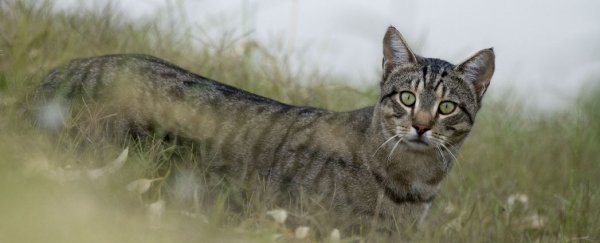A new study has found that trapping and culling might not be the best solution to Australia's feral cat problem - the practice can actually cause an increase in their numbers.
Of all the feral animals currently eating, stomping, and hunting their way through Australia's suburbs, cities, rural areas, and desert plains, none have been quite so disastrous as the cat. According to the ABC, cats are estimated to eat 75 million native animals every night in Australia, which is a rate we can't possibly sustain. Right now, we have the worst mammal extinction rate in the world, with 29 native mammals having become extinct since European settlement, and on a global scale, one in three mammal extinctions in the last 400 years have occurred in Australia.
Culling cats seemed like a pretty straightforward solution, and has become fairly commonplace in the country's most problematic areas. For example, between 2012 and 2013, almost 6,000 of them were culled at a national park in far south-west Queensland in an effort to protect a small population of wild bilbies.
But an accidental finding by researchers in Tasmania suggests that this isn't the smartest way to handle Australia's feral cat problem at all. "You may be inadvertently doing more damage than good," wildlife biologist Billie Lazenby, from the Tasmanian Department of Primary Industries, told Anna Salleh at the ABC.
Lazenby said that the reason culling has been so widely used in Australia is that studies have shown how effective it can be. But the problem is these studies have really only been done on islands, rather than mainland areas such as Australia, where as soon as one cat is removed, another will readily take its place from an eternally self-replenishing population.
This realisation came from a recent study published in the journal Wildlife Research, and conducted by Lazenby and her colleagues in the forests of southern Tasmania. The team looked at populations of small native mammals in areas where feral cats have been left to their own devices, and compared these to populations were cats have been reduced via culling.
And although the culling did what it was supposed to - initially lowered the feral cat population - the researchers found that soon after, the population not only replenished itself within 12 months, but actually ended up increasing.
"In the areas that I had tried to reduce cat numbers, I recorded an increase in cat numbers. I actually had more cats running around on those sites than beforehand," Lazenby told Salleh at the ABC. "We recorded a 75 to 211 percent increase in the minimum number of feral cats known to be alive in the culled areas."
While they're still analysing the results of this study, the team suspects that culling the cats upsets the power balance, and when you remove the dominant individuals, more and more 'subordinates' move in to explore the area.
So what's the solution? Sustained culling could work, because it does effectively reduce feral cat numbers, but the government has to be prepared to keep it up so populations aren't allowed to be replenished. Otherwise, we need to figure out how to live with the number of feral cats we have, and somehow reduce their impact on our wildlife using strategies such as fences, or giving small mammals better places to hide and shelter themselves.
"What we really should be focusing on when we talk about managing introduced species like feral cats is reducing their impact," says Lazenby. "But it's really important that we keep in mind that you don't always reduce impact by reducing numbers, as one individual might cause 90 percent of the damage."
Source: ABC News
